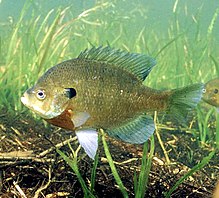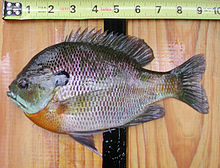Bluegill
- For the exoatmospheric nuclear test, refer to Bluegill (nuclear test).
This article includes a list of references, related reading, or external links, but its sources remain unclear because it lacks inline citations. (June 2010) |
| Bluegill | |
|---|---|

| |
| Scientific classification | |
| Kingdom: | |
| Phylum: | |
| Class: | |
| Order: | |
| Family: | |
| Genus: | |
| Species: | L. macrochirus
|
| Binomial name | |
| Lepomis macrochirus Rafinesque, 1819
| |
The Bluegill (Lepomis macrochirus) is a species of freshwater fish sometimes referred to as bream, brim, or copper nose. It is a member of the sunfish family (family Centrarchidae) of order Perciformes. It is native to a wide area of North America, from Québec to northern Mexico, and has been widely transplanted to stock game fish for anglers. It is commonly fished in Arkansas, Minnesota, Michigan, Wisconsin, Texas and Louisiana, and is the state fish of the U.S. state of Illinois. It is renowned as an excellent tasting fish. They are not relatively common and easy to catch. [citation needed]
Of tropical sunfish body shape, the bluegill's most notable feature is the blue or black "ear", actually an extension of the gill cover called the opercular flap. Its name, however, comes from the bright blue edging visible on its gill rakers. It can be distinguished from similar species by the (not always pronounced) vertical bars along its flanks. The bluegill grows to a maximum overall length of approximately 40 cm (16 in).
Bluegill have a rather bold character; many have no fear of humans, eating food dropped into the water, and a population in Canada's Lake Scugog will even allow themselves to be stroked by human observers.

Bluegills are popular game fish, caught with live bait, flies, hot dogs pieces, raw chicken, corn, small spoons, small crankbaits, spinners, American cheese pushed around a hook, maggots, or even a bare hook[citation needed]. They mostly bite on vibrant colors like orange, yellow, or red, chiefly at dawn and dusk. Some of the easiest baits to use for them are earthworms, live crickets, white bread, cheese, or a corn kernel. Another efficient bait would be redworms or waxworms on ice jigs. They are noted for seeking out underwater vegetation for cover; their natural diet consists largely of small invertebrates and very small fish. The Bluegill itself is also occasionally used as bait for larger game fish species such as blue catfish and largemouth bass. The bluegill is a schooling fish with schools of 20–30 individuals. These fish spawn in June in nests in the shallows. During this period males assume a very bold coloration, as they are guarding their nests. An interesting piece of their biology is that some males assume the coloration of the female fish so that the nest guarding males won't show aggression towards them. Then these "sneaker" males enter nests and spawn. Because of their size and the method of cooking them, bluegills are often called panfish.

They are notorious for their nibbling or pecking style of feeding and commonly steal bait off a fisherman's hook. They hit hard for their size, making it easy to tell when the angler has one on the line. Adult channel catfish, largemouth bass, northern pike, muskellunge, and turtles prey upon bluegill.This makes them excellent bait for catching catfish though you must properly cut them to fit the anglers size hook or the anglers intended sized fish.
In some locations where it has been transplanted, it is considered a pest: trade in the species is prohibited in Germany and Japan. In the case of Japan, bluegill were presented to the crown prince, Akihito in 1960 as a gift by Richard J. Daley, mayor of Chicago. The prince, in turn, donated the fish to fishery research agencies in Japan from which they escaped, becoming an invasive species which has wreaked havoc with native species. The emperor has apologized.[1]
The specific epithet, macrochirus, derives from the Greek μακρός (long) and χείρ (hand).
References
- ^ "Japan in culinary offensive to stop spread of US fish" report by Justin McCurry from Tokyo in The Guardian November 26, 2007
- FishBase: Lepomis macrochirus
- ITIS: Lepomis macrochirus
- Parr, Cyndy Sims. Lepomis macrochirus: Information. Animal Diversity Web. Ann Arbor: University of Michigan Museum of Zoology, 2002.
- Fish anatomy
- Maryann Mott. 'Bluegill Fish Monitor Water Supplies for Terrorist Attacks, Contamination
- Ellis, Jack (1993). The Sunfishes-A Fly Fishing Journey of Discovery. Bennington, VT: Abenaki Publishers, Inc. ISBN 0-936644-17-6.
- Rice, F. john (1964). America's Favorite Fishing-A Complete Guide to Angling for Panfish. New York: Harper Row.
- Panfishing. New York: Stackpole Books. 1984. ISBN 0-943822-25-4.
{{cite book}}:|first=missing|last=(help)
- Malo, John (1981). Fly-Fishing for Panfish. Minneapolis, Minnesota: Dillon Press Inc. ISBN 0875182089.
